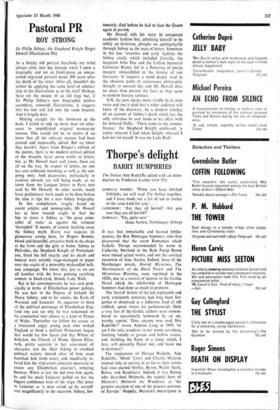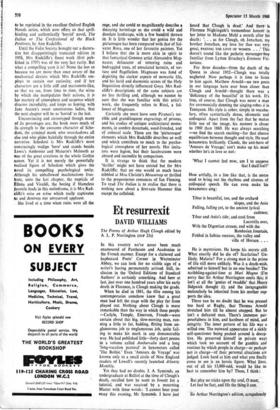Thorpe's delight
BARRY HUMPHRIES
The Italian Ann Radcliffe edited with an intro- duction by Frederick Garber (oup 35s) ISABELLA THORPE: 'When you have finished Udolpho, we will read The Italian together; and I have made out a list of ten or twelve of the same kind for you.' . . .
CATHERINE-: 'Are they all horrid? Are you sure they are all horrid?'
ISABELLA : 'Yes, quite sure.'
(Jane Austen, Northanger Abbey) It was that remarkable and learned biblio- maniac, the Rev Montague Summers, who first discovered that the seven Romances which Isabella Thorpe recommended by name to Catherine Morland in the Bath Pump Room were indeed actual works, and not the satirical invention of Jane Austen. Indeed, three of the Northanger novels, Horrid Mysteries, The Necromancer of the Black Forest and The Mysterious Warning, were reprinted in the 1920s, due to a revival of interest in the Gothic Novel which the scholarship of Montague Summers had done so much to promote.
The 'horrid' fiction of the late eighteenth and early nineteenth centuries had long been for- gotten or dismissed as a ludicrous load of old rubbish; spook stories for parlourmaids. Only a very few of the Gothic authors were remem- bered or occasionally honoured by an un- worthy reprint. 'Does anyone now read Mrs Radcliffe?' wrote Andrew Lang in 1900, 'or am I the only wanderer in her windy corridors, listening timidly to groans and hollow voices, and shielding the flame of a lamp, which, I fear, will presently flicker out, and leave me in darkness!'
The reputations of Horace Walpole, Ann Radcliffe, 'Monk' Lewis and Charles Maturin seemed only to survive in so far as their works had once excited Shelley, Byron, Walter Scott, Balzac and Baudelaire. Indeed, it was Balzac who described Melmoth, the satanic hero of Maturin's Melmoth the Wanderer, as 'the greatest creation of one of the greatest geniuses of Europe.' Happily, Maturin's masterpiece is
to be reprinted in the excellent Oxford English Novels series, which now offers us that spell- binding and authentically 'horrid' novel, The Italian or The Confessional of the Black Penitents, by Ann Radcliffe.
Until the Folio Society brought out a decora- tive but disappointingly truncated edition in 1956, Mrs Radcliffe's finest work (first pub- lished in 1797) was of the very last rarity. But what a compelling yarn it is! None the less so because we are more than once aware of the mechanical devices which Mrs Radcliffe em- ploys to sustain our curiosity; and if her characters are a little stiff and marionette-like, so that we see, from time to time, the wires by which she manipulates their actions, it is her mastery of atmosphere and suspense which disarms incredulity, and keeps us hoping, with Jane Austen's sweet omnivorous ladies, that the next chapter will be as 'horrid' as the last.
Unconvincing and stereotyped though many of its personages are, the book owes much of its strength to the awesome character of Sche- doni, the criminal monk who overshadows all else and who glides balefully through the entire narrative. Schedoni is Mrs Radcliffe's most convincingly malign 'hero' and stands beside Lewis's Ambrosio and Maturin's Melmoth as one of the great creations in the whole Gothic canon. Yet it is not merely the powerfully realised figure of Schedoni which gives the hovel its compelling psychological unity. Although his unhallowed machinations frus- trate, unto the last chapter, the nuptials of Ellena and Vivaldi, the boring if blameless juvenile leads in this melodrama, it is Mrs Rad- cliffe's mise en scene which really captivates us and deserves our unreserved applause.
She lived at a time when ruins were all the
rage, and she could as magnificently describe a decaying hermitage as she could a wild and desolate landscape, with a few banditti thrown in. It is little wonder that her genius for the picturesque has been compared with that of Sal- vator Rosa, one of her favourite painters. Yet I believe that she is more akin in spirit to that fantastical Genoese artist Alessandro Mag- nasco; delineator of tottering ruins and bedraggled trees, of emaciated hermits, of tor- ture and flagellation. Magnasco was fond of depicting the starker aspects of monastic life, and his lurid and daemonic scenes of the Holy Inquisition directly influenced Goya. Mrs Rad- cliffe's descriptions of the same subjects are no less thrilling and, although we cannot be sure that she was familiar with this artist's work, she frequently refers to Ricci, a fol- lower of Magnasco.
Certainly she must have seen Piranesi's ter- rible and grandiloquent engravings of prisons, and his studies of antique architectural monu- ments, in sombre desuetude, weed-fronded, and of colossal scale. These are the 'picturesque' elements which Mrs Radcliffe describes so well and which contribute so much to the psycho- logical atmosphere of her novels. Her imita- tors were legion, but their lucubrations were absurd and incondite by comparison.
It is strange to think that the modern 'thriller' might not have existed but for Mrs Radcliffe; that no one would so much have nibbled at Miss Christie's Mousetrap or thrilled to the preposterous romances of Ian Fleming. To read The Italian is to realise that there is nothing new about a first-rate Hammer film except the celluloid.











































 Previous page
Previous page